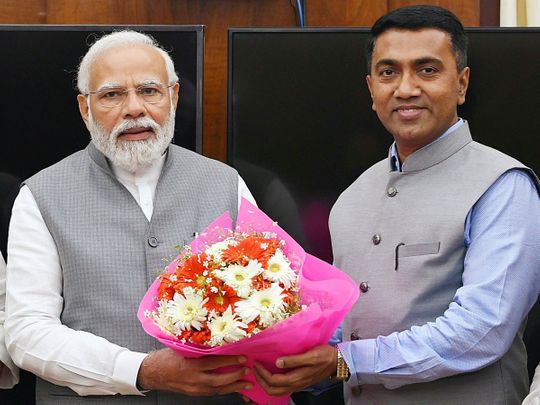
The 2022 state assembly elections in the tiny tourist paradise of Goa was the final act in a drama that began in March 2017 when the Indian National Congress failed to form a government despite being the single-largest party with 17 seats in the 40-member assembly. How the Bharatiya Janata Party (BJP), which won 13, managed to form a government and run it for five years, is a testament to its astute post-poll management strategy and the Congress’ decline in the state.
The Goan electorate, however, was not amused. Two things happened: The Goan youth began to take a keen interest in politics and social issues, leading to a surge in civil society activism. The Revolutionary Goans Party, which contested 39 seats and won one on debut, emerged from this citizens’ movement.
Incidentally, its founding members worked with the Aam Aadmi Party (AAP) when it sought to establish a foothold in Goa back in 2013-14, before eventually parting ways. Secondly, the AAP, which drew a blank in 2017, used the opportunity to strengthen its organisational and volunteer base, winning two seats this time.
Strong anti-incumbency
Despite its bravado, with Chief Minister Pramod Sawant declaring that the party will win 22 seats, the BJP faced strong anti-incumbency. The national media, which descended on Goa in droves despite the all-important Uttar Pradesh election, and the Congress probably thought that Goa was going to see its West Bengal moment.
That was not to be. The BJP, which won 20 seats — one less than in 2012 under Manohar Parrikar’s leadership — is set to form the government with the support of two Maharashtrawadi Gomantak Party legislators and three independents. The Trinamool Congress made a grand entry into Goa just four months before the elections, but drew a blank in all 26 seats it contested.
The BJP’s growth in Goa has been steady, while the Congress risks being irrelevant. The BJP’s vote share has hovered in the 30-35 per cent range since Parrikar rejuvenated its state unit in 2002, while the Congress has declined from nearly 40 per cent to less than 25 per cent in the same period.
Between 2017 and 2022, the Congress saw 16 of its 17 legislators leave the party. The lowest point came in July 2019 when 10 legislators switched over to the BJP en masse.
The numbers game
On the face of it, the numbers seem clear enough, but dig deeper and a different picture emerges. This year, 301 candidates, including a record 68 independents (only three won), were in the fray, the highest since 1994. Victory margins were less than 5 per cent in 11 seats, with the CM himself scraping through by just over 600 votes.
Viresh Borkar, the 28-year-old Revolutionary Goans Party candidate, defeated four-time legislator Francisco Silveira by just 76 votes. Ravi Naik, a former chief minister, won by just 77 votes. Churchill Alemao, a five-time MLA, former chief minister and ex-member of parliament, lost to AAP’s Venzy Viegas by around 1,200 votes.
Both Borkar and Viegas are first-time legislators as is activist lawyer Carlos Alvares Ferreira of the Congress. Articulate and well-informed, these three are expected to keep the government on its toes in the house.
An election of firsts
This is the first time that the BJP contested all 40 seats without an alliance, three couples (two BJP, one Congress) have been elected to the assembly and AAP and Revolutionary Goans have debuted legislators.
The fact that 19 of the 40 legislators are first-timers, including eight from the Congress and five from BJP, speaks volumes about the people’s mood in a state used to seeing the same political heavyweights returning to the assembly election after election. It is also the first time that the legislative assembly has been constituted before the formation of the government. Legislators took oath of office on March 15, five days after the results.
Defections and a comedy of errors
Party-hopping is a favourite game among Goan politicians, and they have justifiably been likened to frogs by many an irate voter. This election was no different with the highlight being former Congress CM Luizinho Faleiro joining the TMC and former BJP minister Michael Lobo switching over to the Congress so that his wife could get a ticket.
In a comedy of errors, one constituency saw a three-time Congress legislator inexplicably switch over to the TMC before election date, only to quit in a month’s time. His closest rival joined the BJP, resigned in 20 days, and jumped on to the Congress bandwagon. Out in the cold, the legislator contested as an independent and was overjoyed to win by a margin of over 5,000 votes.
Vote split or winds of change
Both the Congress and BJP blamed the smaller parties for splitting the vote, but why did the smaller players gain ground in a state dominated for years by the two national parties? The message is clear: The voter is unhappy with the quality of the BJP’s governance, disillusioned with the Congress’ inability to set its house in order, and willing to give new faces an opportunity.
Those dismissing the AAP and Revolutionary Goans as flashes in the pan will do well to remember that the BJP won nothing in the 1984 and 1989 assembly elections, polled double digits (10) only in 1999 and reached an all-time high of 21 seats in 2012.
Unemployment compounded by the mining ban and the pandemic, infrastructure projects being steamrollered at the cost of the environment, and the quality of health care and education in rural areas are among the issues enraging the Goan voter over the last two years.
How the BJP government resolves these challenges will determine its future in a political landscape dominated by a tenacious civil society opposition looking to fill the vacuum left by a weak Congress party.









